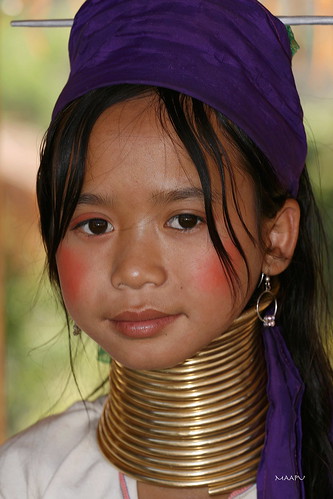 A neck ring is a band of metal worn as an ornament around the neck of an individual. In a few African and Asian cultures multiple neck rings are worn usually to stretch the neck. The Kayan tribe or Padaung tribe of Karen people from the border region of Myanmar and Thailand begin to wear neck rings when they are children. Gradually with age the number of "brass coils" worn increases to elongate the neck. The girls of the Ndebele people of South Africa wear neck rings to signify their marriages.[1]
A neck ring is a band of metal worn as an ornament around the neck of an individual. In a few African and Asian cultures multiple neck rings are worn usually to stretch the neck. The Kayan tribe or Padaung tribe of Karen people from the border region of Myanmar and Thailand begin to wear neck rings when they are children. Gradually with age the number of "brass coils" worn increases to elongate the neck. The girls of the Ndebele people of South Africa wear neck rings to signify their marriages.[1] The custom of wearing neck rings is related to an ideal of beauty: an elongated neck.[2] Neck rings push the collarbone and ribs down.[3] The neck stretching is mostly illusory: the weight of the rings twists the collar bone and eventually the upper ribs at an angle 45 degrees lower than what is natural, causing the illusion of an elongated neck. The vertebrae do not elongate. In advanced stages the forces can cause trauma, such as occlusion of venous flow or hematoma.[citation needed]
The custom of wearing neck rings is related to an ideal of beauty: an elongated neck.[2] Neck rings push the collarbone and ribs down.[3] The neck stretching is mostly illusory: the weight of the rings twists the collar bone and eventually the upper ribs at an angle 45 degrees lower than what is natural, causing the illusion of an elongated neck. The vertebrae do not elongate. In advanced stages the forces can cause trauma, such as occlusion of venous flow or hematoma.[citation needed]When the coils are removed, there is no health danger. The only concern is that the neck muscles are atrophied, and are understandably weaker than the rest of the body. However, there is no proven medical concern for the removal of the coils.[4]
Tourism is often blamed for encouraging the use of neck rings, as they are a popular attraction for tourists.[citation needed]
Small girls may wear brass collars from the age of two to five years old, as it is more comfortable to lengthen the neck slowly. The alternative is rapidly, and painfully lengthening the neck around the age of twelve, when girls first compete for the attention of boys.[5] Marco Polo was the first tourist to describe the practice in c.1300, but refugee practitioners in Thailand were first accessible to tourists in 1984...













No comments:
Post a Comment